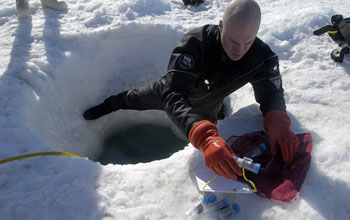Multimedia Gallery
Foraminifera Research (Image 3)
Foraminifera Research (Image 3)
Diver Shawn Harper prepares sample bottles for a dive into the frigid waters of McMurdo Sound, Antarctica, by filling them with water to keep them from floating to the surface. He is standing in the access hole the divers use to reach the waters below. Harper is a member of researcher Sam Bowser's dive team. Bowser, a professor of biomedical sciences at the University of Albany's School of Public Health and a scientist at the New York State Department of Health's Wadsworth Center, is collecting the samples as part of his research on single-celled creatures called Foraminifera.
With support from grants from the National Science Foundation's U.S. Antarctic Program, Bowser's primary research focus has been to try and understand as much of the fundamental biology of Foraminifera as possible, including habitat preference, life cycle, reproductive patterns, eating habits, and evolutionary history.
Foraminifera are among the most abundant organisms in the oceans. They are usually less than 1 millimeter in size, but "larger" Foraminifera may reach the size of a fingernail and are able to capture and eat creatures many times their own mass. Some types of Foraminifera build tiny but sophisticated shells out of grains of sand held together with a natural, but extremely effective underwater adhesive.
Bowser is also interested in the role the creatures play in recycling organic nutrients in the oceans. The huge numbers of tiny animals also act as a "carbon sink," absorbing carbon from the water to make their shells, so scientists are very interested in knowing how the animal's contribute to balancing so-called greenhouse gases, such as CO2, in the atmosphere.
Bowser believes if his research leads to an understanding of the chemistry underlying Foraminifera's naturally produced glue, it could lead to the development of new stronger, waterproof adhesives that could be a boon in fields as diverse as dentistry, neurological surgery and the development of artificial arms and limbs.
For more information, see Bowser's Web site at http://www.bowserlab.org. (Date of Image: Dec. 2006) [Image 3 of 13 related images. See Image 4.]
Credit: Peter West, National Science Foundation
Images and other media in the National Science Foundation Multimedia Gallery are available for use in print and electronic material by NSF employees, members of the media, university staff, teachers and the general public. All media in the gallery are intended for personal, educational and nonprofit/non-commercial use only.
Images credited to the National Science Foundation, a federal agency, are in the public domain. The images were created by employees of the United States Government as part of their official duties or prepared by contractors as "works for hire" for NSF. You may freely use NSF-credited images and, at your discretion, credit NSF with a "Courtesy: National Science Foundation" notation.
Additional information about general usage can be found in Conditions.
Also Available:
Download the high-resolution JPG version of the image. (1.8 MB)
Use your mouse to right-click (Mac users may need to Ctrl-click) the link above and choose the option that will save the file or target to your computer.



